When going for anti-aging procedures, it is worth learning more about the drug Botox and contraindications to its administration. The list of unambiguous restrictions is not extensive. There are several more temporary bans. But it’s better to wait than to waste time and money on restoring health and attractiveness after an unsuccessful procedure.
It is important to familiarize yourself with the possible side effects of injections. In most cases, they are associated with improper rehabilitation and violation of doctor’s instructions.
Who should not inject Botox - the most important contraindications
All contraindications to Botox are divided into absolute and relative. The first means a permanent ban on injections and you need to look for alternative methods of rejuvenation. The second is time restrictions.
Absolute contraindications
These include:
- Myastic syndrome.
- Myapsia.
- Severe gravitational ptosis.
- I'm herniating my eyelids.
- Allergy to the components of the composition.
- Pregnancy and breastfeeding.
- Oncological diseases.
Myasthenia gravis is a disease that leads to disorders of neuromuscular conduction. The effect of Botox injections can aggravate its course and lead to paralysis. This will lead to ptosis, facial asymmetry, drooping eyelids or eyebrows. Side effects will be irreversible.
Serious vision problems - farsightedness, myopia - impose a complete ban on injections in the eye area. Since they can significantly impair vision. But well-executed injections in minimal doses in the forehead area or to eliminate purse-string wrinkles are acceptable after consulting an ophthalmologist.
Severe gravitational ptosis. After the age of 60, when the tissues are very sagging, Botox injections worsen the situation. Due to muscle relaxation, the clarity of the facial oval is lost even more, and the tissues become more swollen.
With a hernia of the eyelids, botulinum toxin type A increases symptoms. The bags under the eyes are likely to increase. This restriction applies to crow's feet. Injections into other areas are permitted.
Oncology does not always impose a complete ban on Botox. Much depends on the stage and treatment received. When using chemotherapy or taking a large number of medications, Botox is definitely prohibited.
In the early stages or in remission, after consultation with the attending physician, the drug can be administered in minimal doses. The patient must understand all the risks and weigh the benefits and possible harms.
Allergic reactions to both the active substance and auxiliary components, especially proteins, impose a complete ban on anti-aging injections. The risk of anaphylactic shock or death is high.
Pregnancy and lactation
There are no comprehensive studies on the dangers of Botox for a fetus or infant. But there is a risk of such. Therefore, in order to avoid serious consequences, cosmetologists refuse injections to pregnant and lactating women.
The use of any drug while carrying or feeding a child is assessed based on its potential benefit to the mother. If treatment is necessary because a woman’s life and health is at risk, medications are used. If there are no such risks, then the drug is abandoned.
Beauty injections can always be done after childbirth or completion of breastfeeding, so no doctor will take risks and exclude possible negative consequences for the child.
Attention! It is often believed that menstruation is a contraindication to Botox. But this is a misconception. There is no evidence of incompatibility between the procedure and this physiological process. But if you have any prejudices about this, it is better to wait until the bleeding is over.
Relative contraindications to Botox
These include the following conditions:
- Inflammatory processes in the body.
- Infectious diseases.
- Dermatological diseases.
- Plastic or other facial surgery.
- Drinking alcohol 48 hours before the procedure.
Various inflammatory processes in the body can be aggravated by botulinum toxin. Therefore, it is important to wait for complete recovery or remission of the disease. Such conditions include a cold, and it is also worth postponing Botox injections.
Since infectious diseases are treated with antibiotics, and some of them are incompatible with botulinum toxin, it is better to temporarily abandon anti-aging procedures.
Plastic surgery or thread lifting are incompatible with injections. After they are completed, complete recovery must occur and only then can Botox be used.
The following dermatological diseases are temporary contraindications:
- herpes;
- erysipelas;
- barley;
- rosacea;
- psoriasis;
- dermatitis of various etiologies;
- acne.
The admissibility of injections can be assessed by a doctor during examination. The drug is administered in the absence of damage and inflammation on the skin. But, for example, with acne on the forehead, it is acceptable to use Botox in other areas.
Botox and ARVI
Separately, it is worth noting that acute respiratory viral infections and acute respiratory infections do not require Botox injections. This is due to the fact that during the administration of the drug, a fever may occur, which will worsen the already not the best state of health. It's better to play it safe and wait a few days until recovery.
Botox for colds, especially those accompanied by high fever, is not recommended. Increased body temperature causes blood vessels to dilate. This may interfere with the “installation” of the drug. Also, because of this, the substance can move to other muscles that were not intended to be immobilized. This will lead to side effects such as drooping eyebrows.
A runny nose in itself is not a contraindication to Botox, but if you have a cold or acute respiratory viral infection, injections should be avoided. It is better to play it safe and speed up your recovery than to minimize the consequences of an unsuccessful procedure.
What other restrictions are there?
In diabetes mellitus there are no direct restrictions on manipulation, but the effect of the active substance on blood sugar levels has not been studied. Therefore, the patient needs additional consultation with an endocrinologist. After injections, you need to carefully monitor your blood glucose levels.
Fluctuations in blood pressure due to hypertension or hypotension can lead to improper redistribution of Botox. It is better to refrain from anti-aging injections and replace them with hardware procedures.
Botox should be used with caution if you have multiple sclerosis or rheumatoid arthritis. The tendency to form keloid tissue may also limit the use of the drug.
How does Botox affect a person?
The active substance of the drug, botulinum toxin type A, is a powerful poison. It is produced by Clostr bacteria >But the substance used in medicine and cosmetology is produced in laboratory conditions. It goes through several stages of sedum. Therefore, in properly selected doses it cannot cause harm to health.
Botox for the face is safe, except in cases of contraindications.
A substance injected into a muscle blocks its nerve endings. Which leads to long-term, sustainable relaxation.
The skin is not deformed due to facial expressions, wrinkles and creases are smoothed out. A woman loses the habit of “using” immobilized muscles.
In medicine, the drug is used in the complex therapy of cerebral palsy to relieve muscle spasms. For the treatment of strabismus, torticollis, and other diseases.
Excessive sweating – hyperhidrosis – can also be successfully treated with Botox. The drug is administered into the armpits, palms, and feet.
The mechanism of action of Botox is described in the video:
Possible complications after the procedure
Negative consequences after Botox occur when the doctor’s recommendations for rehabilitation are not followed, or when the drug is administered incorrectly. Sometimes for the first few days you may experience discomfort at the injection sites and mild headaches.
Complications after rejuvenation may be as follows:
- swelling;
- hematomas;
- numbness;
- facial asymmetry;
- drooping eyebrows;
- spasms of the eyelids;
- immobilization of the upper lip;
- inflammation when the sterility of the procedure is violated.
In women with active facial expressions, wrinkles may appear in other areas of the face. Since the functions of “relaxed” muscles are partially taken over by others.
The substance is eliminated from the body in 4–9 months, depending on the drug, which makes side effects reversible. But this does not mean that you can be negligent about contraindications after Botox injections.
Compliance with rehabilitation rules is important for proper distribution of the drug.
How to avoid complications after Botox procedures
The limitations of the first hours and days after the Botox rejuvenation procedure are due to the fact that the substance takes time to “fix” and begin to act.
Therefore, it is forbidden to bend low or throw your head back for the first 4-6 hours. You can't lie down for about the same amount of time.
You cannot touch your face, much less massage it, for the first two days. Decorative and caring cosmetics are prohibited.
You should also abstain from active physical activity - fitness, swimming, jogging, sex. The ban lasts for several days.
Saunas, steam baths, solariums, and prolonged exposure to direct sunlight are contraindicated in the first week. Do not take a hot bath or blow dry your hair. Any contact with hot air and water is prohibited.
Do not rush to do hardware peelings and cleansing after Botox; they are also on the list of contraindications. Procedures are allowed after three or four weeks.
You need to abstain from alcohol for a week or two, and from long flights.
For the first week, cosmetologists recommend sleeping only on your back.
Botox injections are incompatible with taking antibiotics, anti-inflammatory and painkillers; check contraindications with your doctor in advance.
Compatibility with other drugs
Taking certain medications may affect the effect after anti-aging injections. So, if 21-14 days before the procedure the patient took medications containing ibuprofen or aspirin, there is a high probability of hematomas. Therefore, in consultation with your doctor, it is necessary to stop taking blood thinning medications.
You will have to wait about a month if you were taking antidepressants, drugs that affect neuromuscular activity. Medicines that increase calcium levels in cell membranes. Some antibiotics increase the toxicity of Botox.
At a preliminary consultation with a cosmetologist, it is better to tell about all the medications you are taking or manipulations being performed. This way you will protect yourself from the unwanted consequences of rejuvenation.
Important! Botox injections will be contraindicated if less than a month has passed since laser or ultrasound peeling. Dermabrasion is also a reason to wait with injections.
Recommendations from experts
If in a particular case Botox injections have a large number of contraindications, the cosmetologist will select alternative rejuvenation methods. In case of relative contraindications, experts advise not to rush and wait a while.
An alternative to Botox is mesotherapy, injection of fillers, and thread facelift. When choosing a procedure, it is necessary to take into account the presence of restrictions on them.
A new product in cosmetology, nano-Botox can also become a replacement for injections. In this case, a special composition in the form of a mask is applied to the face; its principle of action differs from injections.
Botox procedure from a dermatocosmetologist:
Advice! Experts recommend not to rush to inject into several areas at once. Since the risk of the so-called wax face is high.
Conclusion
No matter how much you want to look younger and fresher, you should not ignore contraindications to injections. Ignoring them can lead to disastrous consequences, especially in the case of Botox.
Cosmetic procedures allow everyone to achieve ideal facial proportions. The secrets of rejuvenation are used to correct various types of wrinkles and prevent age-related changes. Safe and effective drugs help restore smoothness and elasticity of the skin. Botox on the forehead will relieve muscle hypertonicity and restore beautiful relief.
How does the forehead change with age?
Deformation of the upper part of the face leads to a tired appearance, and decreased elasticity also affects functionality. A shift in the eyebrow line causes swelling of the eyelids, creating visual obstructions. Age-related changes are associated with complex aging - atrophy of subcutaneous tissue, skin dehydration, and deformation of muscle fibers. Parallel horizontal folds form across the entire forehead, as well as vertical wrinkles along the bridge of the nose.
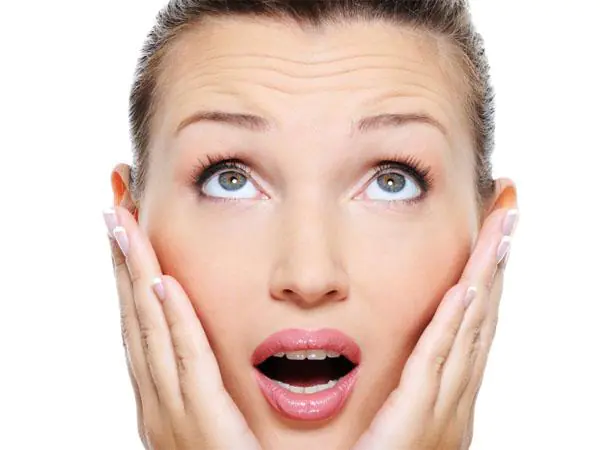
Causes of forehead wrinkles:
- aging leads to the destruction of elastin, collagen, and a decrease in recovery processes;
- increased emotionality is reflected in facial expressions in the form of expressions of anger and anxiety;
- smoking and alcohol accelerate the aging process of the skin and lead to oxygen starvation;
- excessive physical activity, professional sports;
- exposure to ultraviolet radiation, visiting solariums, sunbathing;
- sudden weight fluctuations, lack of drinking regime;
- unfavorable environmental situation.
The first wrinkles can be noticed by the age of 27–30, after 35 years the folds are clearly visible, the changes lead to a shift in the eyebrow line. By the age of 45–50, deep furrows form on the forehead, swelling of the eyelids leads to sagging of the outer corners of the eyes.
Indications for use
The action of drugs from the botulinum toxin group is aimed at blocking a specific protein that acts on muscle contraction. As a result of the injection, temporary muscle paralysis occurs, even deep facial wrinkles are smoothed out. Over time, new neuromuscular connections will form, which means repeated administration of the drug will be required.
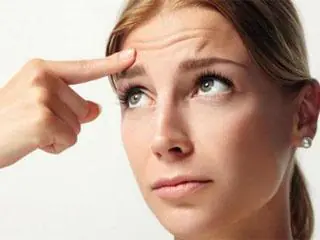
Indications for the use of Botox:
- horizontal and vertical wrinkles on the bridge of the nose;
- horizontal wrinkles in the forehead;
- pronounced facial asymmetry;
- Crow's feet are wrinkles on the outer corners of the eye.
Botox injections are effective for early and middle signs of aging, age range - from 30 to 60 years. The drug has also been successfully used to correct facial asymmetry starting from the age of 18. Injections can restore youth, remove signs of fatigue, and give expressiveness to the look. After 55–60 years, in addition to the toxin, additional aesthetic procedures are used.
Note! The complex may include fillers, laser resurfacing, and contour lifting. Botulinum toxin injections are not used to form sculpted cheekbones or tighten oval shapes.
Preparation for the procedure
For successful rejuvenation and correction of age-related changes, it is important to know the factors influencing the results of beauty injections. It is not recommended to administer injections during drug treatment, as well as in the presence of chronic diseases.
During the consultation, it is important to tell the cosmetologist whether there are any allergic reactions or problems with blood flow.
Preparation:
- for 2 weeks you should stop taking fish oil, ibuprofen, aspirin, Excedrin, antibiotics, herbal remedies, homeopathic medicines;
- It is not recommended to drink alcohol or smoke for a week - these factors increase the risk of bruising.
Drug manufacturers
When choosing a brand of drug, you need to focus not only on the brand, cost, but also possible allergic reactions and side effects.
Botox
Produced by the American company Allergan. Over decades of use, it has established itself as an effective and safe injection. The result lasts from 4 to 6 months. Relaxes fibers by destroying neuromuscular connections. The high cost is justified by the claimed effect of smoothing out facial wrinkles.

Botulax
The drug is produced in South Korea. It is based on botulinum toxin type A hemagglutinin, sodium chloride. Schemes and dosages are similar to Botox. One of the most effective analogues, the result appears already in the first day. Economical to use, can be used for all areas of the face.
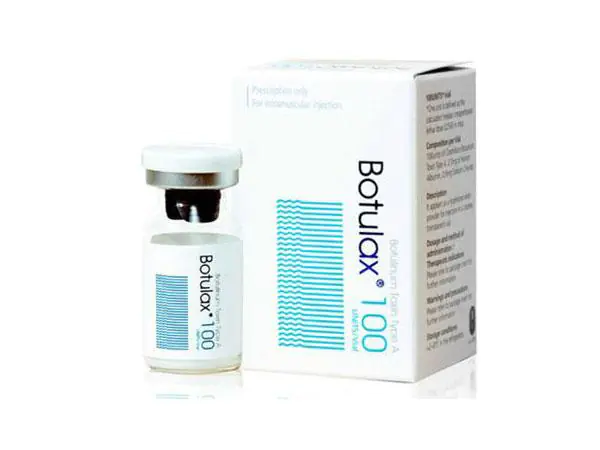
Dysport
The French-made drug has an enhanced effect compared to Botox. The effect is observed in the first week and lasts up to 5 months. The painlessness of injections and the absence of muscle fiber atrophy made Dysport popular not only among patients, but also among cosmetologists.
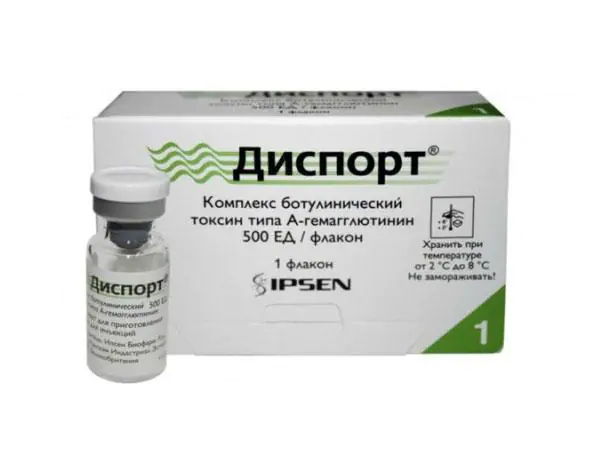
Relatox
The domestic product has a number of advantages. Affordable price, visible effect within an hour, preservation of aesthetic correction for up to 9 months. The disadvantages include the painfulness of the procedure and often observed allergic reactions. Also the drug cannot cope with deep wrinkles.
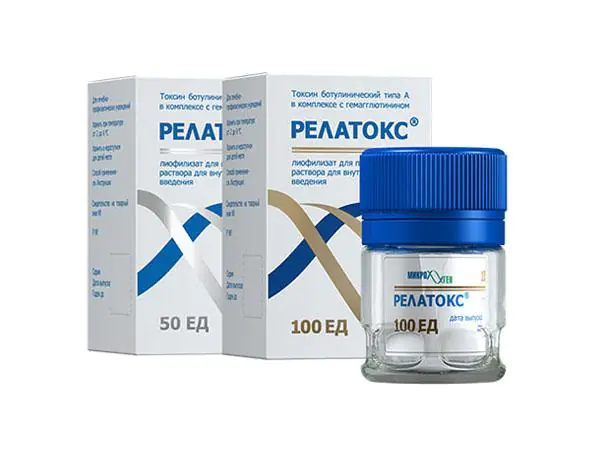
Xeomin
The European analogue of Botox is resistant to external factors. Persistent changes are observed after 2 weeks. The risks of developing allergic reactions and side effects are reduced. Ineffective for correcting deep age wrinkles.
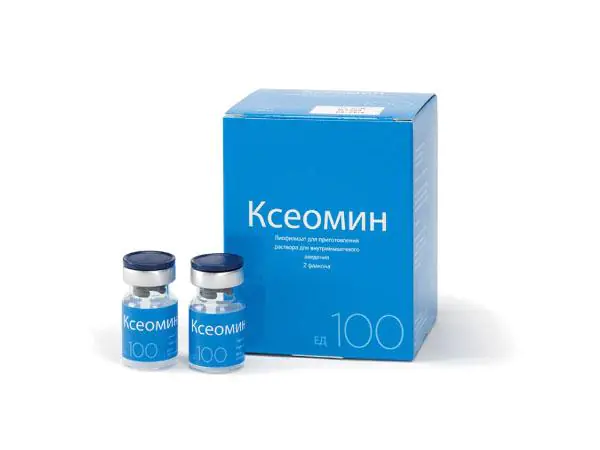
Lantox
A budget analogue of Botox, produced in China. Helps smooth out wrinkle networks in the forehead and neck. It often causes discomfort, pain, and has an impressive list of contraindications.

Injection safety
Side effects, overdose, complications are the downside of the popular procedure. In order to reduce the risks of undesirable consequences, it is important to pay attention to the following factors:
- choose a clinic that has been operating for at least 5–10 years, read the portfolio, as well as patient reviews;
- Only a cosmetologist or a plastic surgeon can perform injections; taking Botox courses is not enough, you need to thoroughly know the anatomical features of the face;
- The botulinum toxin preparation must not only be from a well-known manufacturer, you need to review the quality certificates, compliance with the batch number and expiration dates;
- the diluted drug can be stored for no more than 4 hours under certain conditions, so it is better to discuss the preparation with your doctor immediately before the procedure;
- the patient must sit on a couch, the head is fixed with a soft support, after the procedure the doctor will monitor the patient’s condition for half an hour.
Carrying out the procedure
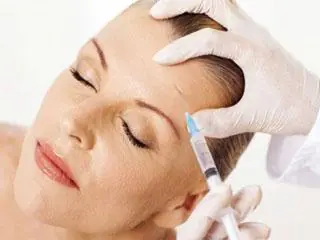
The gold standard is considered a complex correction, in which the drug is injected into the forehead, bridge of the nose, and between the eyebrows. The doctor conducts a general diagnosis of skin turgor, determines the type of wrinkles and anatomical features of the upper part of the face.
Before injecting the drug, photographs are taken in a relaxed and frowning manner to select a strategy for the procedure. The correction takes from 10 minutes to half an hour, after which you need to stay for some time to monitor the condition.
Procedure steps:
- The forehead is treated with a disinfectant.
- The patient frowns for the cosmetologist to determine the correction zones; the points are marked with a special marker.
- In case of painful sensitivity, treat with anesthetic ointment.
- Botulinum toxin is injected, minimal discomfort; a thin needle is used for injection.
- For the forehead area, on average, it requires from 15 to 30 units.
- After the injections, a cold compress is applied to help narrow the blood vessels.
Cosmetologists recommend carrying out comprehensive rejuvenation, injecting the drug not into individual areas, but over the entire upper part of the face. This will allow you to achieve the most natural result.
Like The forehead correction procedure and injections between the arches of the eyebrows follow the standard scenario:
- The area is treated with a disinfectant.
- Then the points for administering the drug are outlined; for this you need to grimace a little so that the doctor determines the target zones.
- Using an ultra-thin needle, the drug is injected at an angle of 45° or 90°, to a depth of approximately 7 mm.
- To avoid drooping or asymmetry, the distance from the arches should be 2 cm.
- This small area will require a high concentration of toxin - an average of 10 to 20 units.
Attention! It is also important to maintain the same dosage, injecting an equal number of units into the right and left half of the bridge of the nose.
Photos before and after
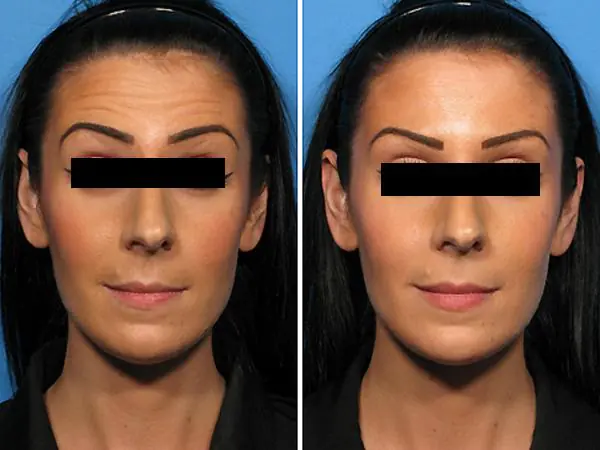
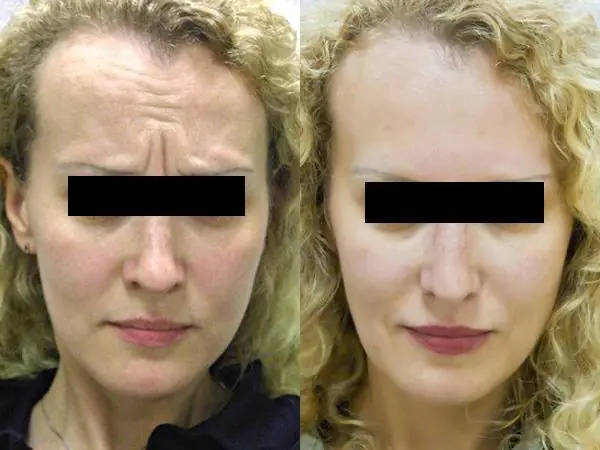
Healing period
A special feature of the procedure is a fairly short rehabilitation period. On the first day, swelling and redness of the injection area may appear. But the marks quickly disappear, so it is easy to hide cosmetic procedures from others.
On average, facial wrinkles are smoothed out within 5–7 days; the maximum effect can be assessed after 2 weeks. The result lasts from 3 to 6 months, but if you carry out several procedures, gradually increasing the dosage, the period increases to a year.
Care rules:
- in the first 4–6 hours, you should not bend over, touch your face, expose your skin to heat, or lie down; it is important to maintain an upright position;
- on the first day you cannot fly, take a bath, take a hot shower, perform cosmetic procedures, touch the injection area, bend over, eat salty, spicy, hot foods;
- for 2 weeks after injections, you should not take medications, including antibiotics, drink alcohol, coffee, tea, smoke, go to the beach, swimming pool, sauna, solarium, play sports or exhausting physical labor;
- For a month you cannot do peeling, facial massage, hardware or physiotherapy procedures.
Cost of services in Moscow clinics
The price of the procedure depends on the brand of the drug and the area that needs correction. The cost is also influenced by the prestige of the clinic and the qualifications of the cosmetologist or plastic surgeon. You can calculate how much botulinum toxin injections will cost yourself by finding out the price of a unit of the drug - it ranges from 300–500 rubles.
For the frontal and eyebrow area, on average, from 12 to 30 units are required, the amount depends on individual characteristics. A cosmetologist can accurately calculate it during a consultation. Often used with other procedures: chemical peeling, contour lifting, filling wrinkles with fillers.
Precautionary measures

Before the procedure, a consultation with a doctor who takes the patient’s medical history is required. The importance of this stage should not be underestimated; additional tests may be required to identify hidden conditions. It is easier to prevent side effects than to correct aesthetic defects later.
Contraindications:
- pregnancy, lactation period;
- chronic diseases;
- damage to the integrity of the skin;
- carrying out drug treatment, taking antibiotics;
- epilepsy;
- pathologies of the endocrine, nervous, circulatory system;
- infectious diseases, fever, high temperature;
- individual intolerance;
- diabetes;
- menstruation;
- postoperative period.
Possible complications usually appear in the first week after the procedure. But even unexpected phenomena go away on their own, since the toxin is completely eliminated from the body. There may also be discomfort that does not affect the aesthetic result:
- pain in the injection area;
- hematomas;
- swelling;
- headache;
- dizziness;
- tearfulness.
Side effects:
- spasms of the eyelids;
- asymmetry, displacement of the eyebrow line;
- ptosis - drooping of the eyelid, up to complete closure of the eye;
- feeling of double vision;
- absence or decreased effect due to destruction of the toxin by antibodies of the immune system.
How to speed up the removal of Botox
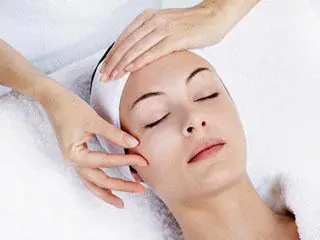
Complications from injections are rare and are the result of incorrect dosage or incorrectly selected injection points, calling into question the professionalism of the cosmetologist. Also, side effects may occur due to the patient’s fault if he did not adhere to the recommendations during the recovery period.
To eliminate side effects, you need to contact an experienced cosmetologist. He will not only select a rehabilitation program, but will also monitor the progress of the procedures.
Methods to speed up the removal of Botox:
- Face massage — lymphatic drainage will help speed up blood flow, remove lymph stagnation, activate metabolic processes, and therefore remove toxins.
- Physiotherapy — the most popular is microcurrent stimulation. Under the influence of electric current, neuromuscular connections are created, which allows the motor activity of the fibers to be restored.
- Taking hormonal drugs and antibiotics significantly accelerates the elimination of botulinum toxin. But the choice of drugs and dosage regimen are prescribed by the doctor, taking into account the patient’s medical history.
Advantages and disadvantages
Beauty injections allow you not only to preserve youth, smooth out wrinkles, but also to forget about aesthetic shortcomings.
Advantages:
- getting rid of facial wrinkles;
- correction of facial proportions;
- increasing effect within 2 weeks;
- painlessness of the procedure;
- short recovery period;
- the toxin is eliminated on its own;
- the habit of not frowning your eyebrows and forehead becomes established.
The disadvantages of botulinum therapy include short-term results and the occurrence of an addictive effect. With regular administration of toxins, the immune system produces specific substances that neutralize the paralytic effect. Also, you should not expect wrinkles to smooth out after 55–60 years; a complex of anti-aging procedures will be required. The myths that botulinum toxin is dangerous have no evidence; the possibility of use without harm to health has been clinically proven.
Opinion of cosmetologists
On the forums you can find not only opinions on working with drugs based on botulinum toxin. Cosmetologists share their experience in correcting the forehead area.

The user writes about the occurrence of side effects and methods of removing the toxin.
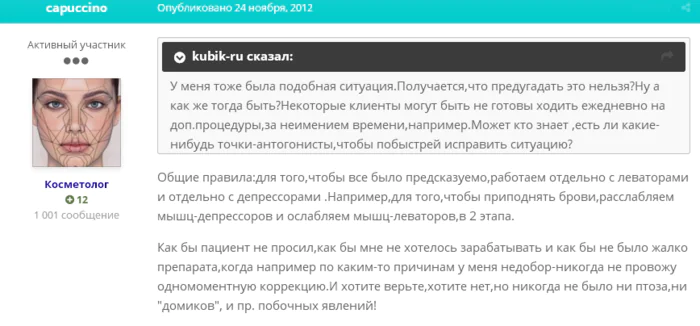
The participant points out the need for multi-level work to achieve the desired effect.
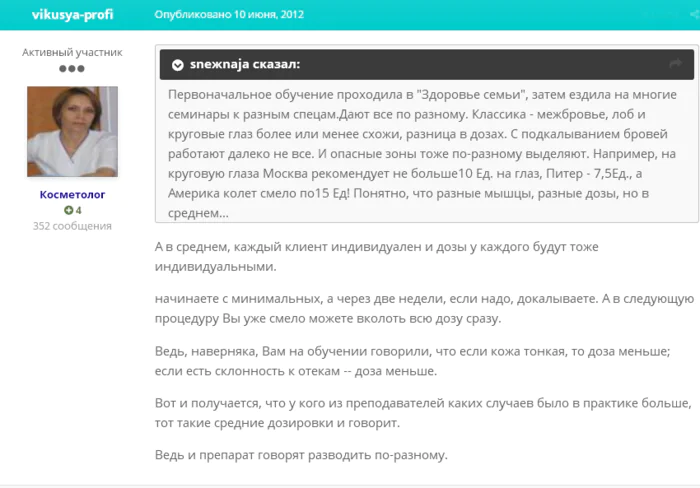
The user writes about the individual characteristics of each client and the need to correctly calculate the dosage.

The participant describes technical recommendations to prevent the spread of the drug in non-target areas.
Patient reviews
Opinions from those who have already experienced the effect of Botox are mostly positive.

The user writes about the successful smoothing of the eyebrow fold and the absence of harm to health.

A participant talks about getting rid of the furrowed brow expression.
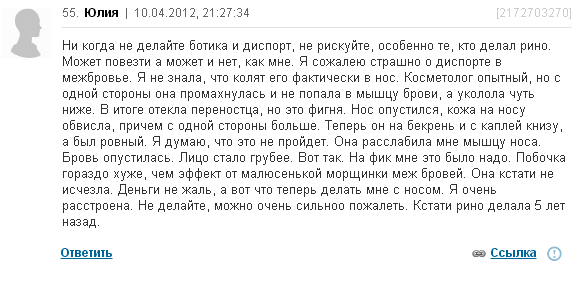
The patient writes about side effects in the form of swelling of the bridge of the nose, displacement of the nose and the lack of effect in eliminating wrinkles.
Other reviews can be found on the forum.
Useful videos
Botox injections in the area: upper third of the face, forehead, between the eyebrows.
Botox is a popular, quick and fairly safe procedure that allows you to give your face a more youthful and fresh appearance. Injections smooth out wrinkles, and by following recommendations after Botox on the foreheadgiven by the doctor, the patient will be able to avoid their reappearance for a long time.
Main contraindications for Botox
Although Botox is safe in most cases, there are some limitations to its use. These include:
- Pregnancy and lactation - safety for the fetus has not been proven;
- Blood clotting disorders - risk of bleeding and hematoma formation;
- Impaired skin regeneration, tendency to scar formation;
- The presence of scars and foci of inflammation at the injection site and in its immediate vicinity;
- Allergy to botulinum toxin.
In all these cases, the positive effect of the procedure will be completely canceled out by the negative aspects and side effects. Therefore, if the patient comes to such a procedure for the first time, the doctor will identify possible contraindications in great detail.
What happens with Botox injections?
Botulinum toxin is one of the most powerful natural poisons. It causes a severe form of poisoning, the symptoms of which include persistent paralysis of skeletal muscles. It is this property that was used to create the drug. In small doses, the toxin is almost completely harmless, and its effect is limited only to the area of injection.
Botox paralyzes the facial muscles, while relieving tension in the skin, making it smoother. Wrinkles between the eyebrows straighten out, “surprised” folds along the edges of the forehead disappear, and the contours of the face become clear.
Before the procedure, you need to completely remove makeup from your face and wash your face - after the injections you won’t be able to do this for some time. There is no need to rub your face forcefully - this will cause excess blood flow and increase the risk of discomfort during the procedure.
What should not be done after Botox on the forehead in the first hours?
The first 3-4 hours are the time when the drug can move under the skin and has not yet begun to have an effect. The effect is not visible at this time - the muscles remain in the same state. But this is the most important time, and then the most difficult restrictions are placed on the patient - because if they are not followed, the drug will end up in a completely different place than where it was administered, and the result will be spoiled.
The first thing you should not do at this time is to lie down, especially face down, bend over and tilt your head - this can lead to displacement of the drug. Also the forehead should not be touched with hands, massaged, warmed or cooled. You should also watch your facial expression - too active facial expressions can also cause harm.
It is not very convenient to follow these recommendations, but this allows you to avoid in the future the incorrect distribution of the drug and the manifestation of the effect in a completely different place than where it should be.
You can also wash your face only 4 hours after the procedure.
Botox on the forehead and between the eyebrows: what should not be done after the procedure for 14 days?
After the most difficult hours after the procedure have passed, the recovery period does not end. It lasts about 2 more weeks. At this time, the toxin exerts its effect, binds to the muscles and paralyzes them, and the skin gradually returns to the desired state. All this time, the risk remains that the result of the procedure will be spoiled.
At that time Direct sunlight and tanning in a solarium are contraindicated. It's not just a matter of ultraviolet light hitting the skin, but also overheating, which changes the distribution of the drug under the skin. Therefore, the beach and solarium will have to be cancelled, and it is advisable to move along the street in the shade, covering your forehead with a hat or bangs.
Treatment area Do not touch with cosmetics, any care products, massage or perform facial exercises. It is also necessary to follow a diet - avoid large amounts of liquid and salt, which provoke swelling.
How to sleep with Botox? It is advisable to do this on your back so that the pillow does not touch your face. You can go to bed for the first time 5-6 hours after the procedure. It is advisable to get a good night's sleep before it, so that strong yawning or the desire to sleep does not lead to violation of the recommendations in the first 4 hours after the injections.
Botox and sports: reducing stress
There are no contraindications for sports after completion of the rehabilitation period - as soon as 14 days have passed after the procedure, the patient can think about physical activity.
Sports do not affect the distribution of the drug in the muscles after the stated 14 days have passed. Until this point, physical activity should be as minimal as possible. Afterwards, the patient can indulge in breathing exercises, stretching, jogging and training in the gym. But you should be prepared for the fact that the results of the injections will not last as long as you would like.
As for when you can engage in professional sports, the answer is obvious - high-performance sports and Botox are incompatible with each other. Firstly, active physical activity in professional athletes greatly shortens the duration of action of the toxin; in some cases, wrinkles may return within a month. Secondly, the skin irritation reaction intensifies, headaches and other side effects appear.
Botox and medications: combining correctly
Recommendations regarding medications should be obtained from specialized specialists. The dermatologist will warn you about some of them before the session, but you will have to ask about others every time if necessary.
Usually the dermatologist warns what medications should not be taken immediately after Botox?:
- Muscle relaxants and premedication drugs (used in surgery), so Botox should not be done before a planned operation;
- Antibiotics – aminoglycosides, polymyxins, tetracyclines;
- Magnesium sulfate (used to reduce blood and intracranial pressure and as a laxative).
There may be additional restrictions that you should ask your doctor about before you start taking the drug. If the patient is undergoing surgery, it is better to postpone Botox until after it. If the operation is performed for emergency reasons, and the toxin has already been administered previously, surgeons should be warned that a more pronounced than usual reaction to muscle relaxants is possible.
Botox and bad habits
Self-care after Botox includes not only restrictions on sports, but also on bad habits.
The second common bad habit - smoking - also has a bad effect on the condition of the skin. Nicotine constricts blood vessels, slows down the effect of the drug, and during the rehabilitation period prolongs the time during which adverse factors can affect the face. Therefore, the less the patient smokes, the longer he will maintain his beautiful appearance.
Is it possible to drink coffee, sleep little and do you need to follow a regime? During the rehabilitation period - necessary. Coffee, like alcohol, retains water in the body, contributing to the development of edema. Lack of sleep is dangerous not only due to bags under the eyes, but also due to impaired distribution of the drug on the forehead. Therefore, it is advisable to follow a routine and restrain yourself in your love of coffee and late-night gatherings.
October 4, 2018 | 1:01 pm
I had Botox injections in the area between my eyebrows and my forehead was pierced. I think Botox is the best drug for the forehead. All the wrinkles smoothed out incredibly, even the two deep ones on the bridge of my nose. The forehead looked like marble!
The effect lasted for a year and began to disappear after the eighth month.
In addition, I do bodybuilding, although not professionally. But I reduced my training to two per week. I excluded visiting the steam room in the bathhouse. But basically everything is the same. Alcohol is rare, but a cup of coffee in the morning.
Smoking…..No, I couldn’t give up smoking, I confess! 😁
I would like to add that after you have done Botox, try to sleep on your back for two weeks! My friend was let down by her habit of sleeping on her stomach. After such a dream in the first days after the procedure, one eyebrow rose. I had to re-level it with the same Botox.



